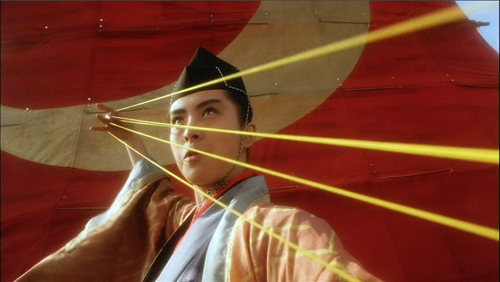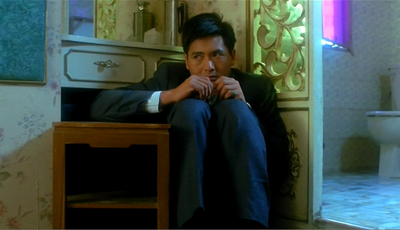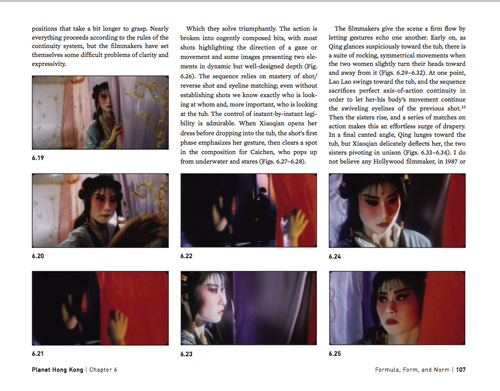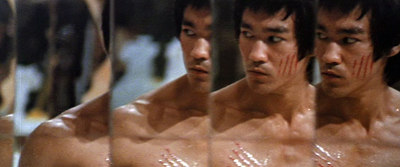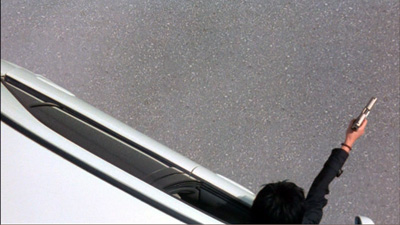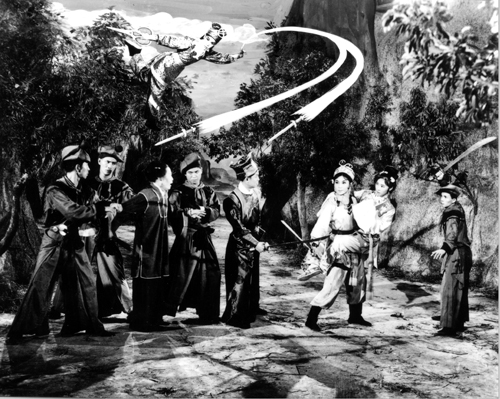Revisiting Planet Hong Kong
Friday | December 10, 2010 open printable version
open printable version
The East Is Red (1993).
DB here:
In about two weeks, we try something new here. It’s an experiment in self-publishing, like everything on this site, but this time we offer a new version of an oldish book.
Planet Hong Kong was published in 2000. It sold pretty well for an academic book, shifting about 7000 copies through 2007. It was translated into Chinese twice, once in Hong Kong and once on the mainland. It also got encouraging reviews; I’ve put up links at the end of this entry.
At some point in 2008, Harvard University Press took the book out of print, a decision I learned about accidentally in spring of 2009. The story is here.
Since then, the book has become rather scarce; only about twenty copies are currently offered on Amazon. Rather than letting the poor thing fade away, I considered revising it for the web. The more I thought about it, the better the prospect looked. I could add as much to the text as I wanted. The text could be corrected, updated, and supplemented in the future. I could add photos, lots of them, and they could be in color. The text would be searchable. And instead of waiting nine to thirteen months to see the result, I could see it in weeks.
Moreover, readers could use the book as they liked. If it was presented as a pdf download, they could read it on a computer or on several models of e-book readers. They could also print out all or part of it. Interestingly, when I asked students and faculty if they’d use the book, nearly all said they’d print it, or let a facility like Kinko’s do it. All in all, it looked like an experiment worth trying.
[Insert montage of fluttering calendar pages here]
God of Gamblers (1989).
Since July I’ve spent virtually all my time on the book, with a break to go to the unmissable Vancouver film fest. Reworking the manuscript, watching and rewatching films, and preparing new material kept me from writing other things I had planned. No blog for Godard’s eightieth birthday, aiming to defend Film Socialisme as an intelligible part of his career. No web entry on the remarkable films of Kon Satoshi, creator of Perfect Blue, Millennium Actress, and The Girl Who Leaped through Time. No discussion of the 1950s-1960s art-cinema canon in the light of Tino Balio’s fine new book on that period in U. S. film culture. No speculations on the psychological processes aroused by a movie’s opening scenes. Maybe next year.
Instead, apart from two quick entries provoked by Inception, I was absorbed in Hong Kong movies on film and DVD, notes from ten years of film festivals and conferences, and plenty of books and websites. Two blog entries, one on coincidence and the other on Jackie Chan’s Police Story, were chips from the workbench. As for my seeing recent releases, The Social Network and Megamind have been about it.
Now, after a month of fourteen-hour days, Planet Hong Kong redux is close to ready. I hope to make it available on this site during the week of 20 December.
The beast has grown in captivity. The first edition ran about 130,000 words; the new version adds 40,000 words. (In defense, I remind you of Adorno explaining why The Authoritarian Personality turned out so long: “We didn’t have enough time to make it short.”) There are over 150 new stills, all in color and many from 35mm prints. But no clips! These films are too beautiful to be reduced to those wretched mutants you get on YouTube. Besides, I don’t have the rights.
Planet Hong Kong 2.0 will not be free. My Ozu and the Poetics of Cinema and Kristin’s Exporting Entertainment are free online, but neither of those was revised, and we absorbed comparatively little of the costs of production. By contrast, the digital PHK is the fruit of a lot of paid labor. Heather Heckman and Mark Minett did excellent scanning and Photoshop tweaking, and Meg Hamel, our web tsarina, designed the book and is making it web-ready. I’m still reckoning the cost of the e-book, but it will be $20 or less. Payment will be rendered unto Caesar, aka Caesar Bordwell, via PayPal.
Here’s a sample page from our beta version. I’m still fiddling with the text, but the design looks to me like a nice compromise between the stability of a book page and the flow of a website. The file I’m using here is low-resolution, and this frame from it is a paltry 72 dpi jpeg, but the final pdf page should look very sharp. For curious boffins, the 35mm frame stills were scanned at 2000 dpi and reduced to 300 dpi for insertion. We don’t know yet how big the whole book’s file will be, but of course Meg will optimize it for downloading.
By the way: No, Wong Kar-wai did not invent the luscious image of the yearning woman.
Once the book is up, I plan to add a Hong Kong picture gallery to this site. It will include snapshots of celebs and fans from across the years 1995-2010.
ISNAQs (Infrequently, Sometimes Never, Asked Questions)
Enter the Dragon (1973).
PHK isn’t a comprehensive history of Hong Kong filmmaking; for that you must turn to Stephen Teo’s Hong Kong Cinema: The Extra Dimensions. Nor is it a fan’s guide to the wild and crazy side of this local cinema. Stefan Hammond’s two books handle that task nicely, and there are many similar handbooks since. Most strikingly, the fanboys have been usurped by the professors. A geyser of academic books and articles about Hong Kong cinema burst in the new millennium, along with invaluable documentation from the Hong Kong Film Archive and the Hong Kong International Film Festival. My book doesn’t rival these.
What does this book do, then?
I try to design my books in layers, with different implications and possibly different readerships, at each level. The first and founding layer of Planet Hong Kong is my effort to convey the sheer pleasure offered by this filmmaking tradition. I write as an enthusiast for other enthusiasts, and for potential converts. In this respect, PHK is an academic dressup of a noble gonzo tradition. Hong Kong cinema has benefited from the gusto of admirers like Ross Chen, Lisa Morton, Stephen Cremin, Grady Hendrix, Stefan Hammond, Chuck Stephens, Richard Corliss, David Chute, Howard Hampton, and other lively writers. This cinema inspires dazzling, sometimes headbanging appreciations from critics.
Next there’s a historical layer. Hong Kong cinema is, I’m convinced, an important “national school” in world film history. It shaped global popular culture to a degree matched only by the westerns and gangster films turned out by the Hollywood studios. Every video game that includes martial arts, every American action movie, and every comic book showing a sword-wielding superhero owe a lot to Bruce Lee and the cinema he springs from. Less obviously, Hong Kong innovated approaches to film form and style that remain striking today. When I wrote the book, this artistic heritage was almost completely unappreciated, by both general audiences and specialized film scholars. The situation is a little better now, but the case always needs restating. Through close analyses of many films and sequences, the book tries to show the originality and force of the Hong Kong touch.
Another layer up, the book asks how popular cinema works. The clichéd split between “art” and “business” isn’t much help in understanding mass-entertainment film. The business relies on artistic traditions, and those traditions in turn are born from and shaped by industrial factors–not just constraints but also enabling opportunities. Hong Kong film provides a case study in how a mass-entertainment movie builds its effects on genre, star appeal, storytelling strategies, and stylistic tactics. It shows vividly how a media industry relies on conventions, and how artists tap those, stretch them, and sometimes twist them out of recognition. My interviews with several writers, directors, choreographers, and actors helped me understand the ways that creativity could be fostered by craft traditions.
At the most general level, PHK is a small-scale demo of an approach to asking questions about cinema. It shows how we might systematically study the principles of construction informing popular filmmmaking. Stealth poetics, in other words.
The old and the new
Leave Me Alone (2004).
The big changes in Asian cinema of the last decade make the original book something of a historical artifact itself. I did the research across the 1990s and wrote nearly all of it in 1998. Its emphases reflect issues circulating in fan and academic culture at that time. DVDs, introduced in 1997, had not become widespread, and VCDs were unwatchable. (Still are.) Most of the films that mattered had to be studied on film copies, although laserdiscs offered a passable backup in some cases. VHS tapes were seldom letterboxed, but laserdiscs often were.
The biggest constraint on the book was the scant availability of Shaw Brothers films on any format. Thanks to the Hong Kong International Film Festival, trips to archives, and the film collector’s market, I was able to see quite a few, but nothing like what’s available now in the massive and restored Shaw DVD library. Consequently, apart from the work of King Hu, Chang Cheh, and Lau Kar-leong, PHK doesn’t deal with the very interesting output of the territory’s most famous company. Fortunately, Shaws has been carefully studied in the years since my book, in a massive volume from the Hong Kong Film Archive and in Poshek Fu’s China Forever: The Shaw Brothers and Diasporic Cinema. For my part, this web essay and these blog entries try to make amends.
I could have recast PHK top to bottom, but I wasn’t convinced that I could come up something as pointed as the original. The text has been corrected, of course, and patches have been recast for greater clarity. It has also been enhanced by a few more examples, film sequences I referred to in passing but could not illustrate because I couldn’t find a print or couldn’t include color images. The chief updating is a series of sections added to the back end.
So here is what the book now looks like.
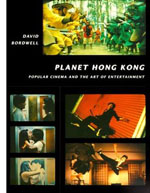 The first chapter broaches the general idea of an aesthetic of popular cinema. There follows an interlude comparing Hong Kong and Hollywood, focusing on The Untouchables and Gun Men. Instead of launching into a general history of local cinema, Chapter 2 sketches some general features of the territory’s film culture, concentrating on its audiences and its critics. The following interlude,”Two Dragons,” talks about Bruce Lee and Jackie Chan, the two most famous Hong Kong heroes. Chapter 3 provides a condensed history of Hong Kong filmmaking up to 1997. The next chapter, “Once Upon a Time in the West,” traces how Hong Kong film attracted fans and festival prestige. There’s an interlude devoted to John Woo, then the fanboys’ demigod.
The first chapter broaches the general idea of an aesthetic of popular cinema. There follows an interlude comparing Hong Kong and Hollywood, focusing on The Untouchables and Gun Men. Instead of launching into a general history of local cinema, Chapter 2 sketches some general features of the territory’s film culture, concentrating on its audiences and its critics. The following interlude,”Two Dragons,” talks about Bruce Lee and Jackie Chan, the two most famous Hong Kong heroes. Chapter 3 provides a condensed history of Hong Kong filmmaking up to 1997. The next chapter, “Once Upon a Time in the West,” traces how Hong Kong film attracted fans and festival prestige. There’s an interlude devoted to John Woo, then the fanboys’ demigod.
Chapter 5 surveys the industry, with emphasis on filmmakers’ craft traditions (how stories are planned, scenes are cut, and so on). The interlude that follows takes Tsui Hark as an instance of a director who creatively reworked such traditions. Chapters 6 and 7 go into the most detail about the aesthetics of Hong Kong film, surveying the dynamics of genre, the star system, visual style, and plot construction. Between these two chapters is sandwiched an interlude devoted to Wong Jing, the most disreputable major filmmaker in the territory. The longest chapter, the eighth, explores the distinctive aesthetic of action pictures, from martial arts to contemporary crime movies. The interlude that follows discusses three outstanding directors in the martial-arts tradition: Chang Cheh, Lau Kar-leung, and King Hu. The final chapter of the original book considers how the premises of popular cinema can be adapted to create “art films.” The principal, but not sole, example is the work of Wong Kar-wai. The original book concluded with an analysis of Chungking Express.
The new material in this edition starts with a chapter on changes in the film industry since 1997. That’s followed by an interlude focusing on the Infernal Affairs trilogy, which was as you know the source for The Departed. The next chapter considers how the artistic trends surveyed in the first edition have changed over the last ten years or so. While discussing developments in genre, storytelling, technology, and style, the chapter includes sections on Stephen Chow (particularly Shaolin Soccer and Kung-Fu Hustle), Wong Kar-wai (In the Mood for Love and 2046), and Johnnie To Kei-fung. The final interlude is a more in-depth discussion of To’s crime films and their relation to the indigenous action-movie tradition. At the very end is a new bibliography and endnote citations.
Readers not drawn to Hong Kong cinema might find my more general arguments of interest. For example, I suggest that Hong Kong shows us how important regional and diasporan networks are in creating and maintaining a film culture. To the claim that films reflect their societies, I reply that Hong Kong films suggest a different way to think about such a dynamic, using the model of cultural conversation. Readers interested in fandom should find something intriguing in the story of how cultists around the world helped establish Hong Kong film as a cool thing in the early 1990s. I also argue against the tendency in film studies to assume that when a film tradition doesn’t follow the rules of classical plot construction it must be based on something called “spectacle.” I suggest instead that we need to study principles of episodic plotting, which are probably quite common in popular art generally. In these and other areas, I wanted to use this cinema as a way into thinking about popular moviemaking as a whole.
After World War II, a tailor shop in Hong Kong put up a sign: “Reopening soon. Sooner if possible.” The same goes for me: Planet Hong Kong Redux is coming soon. Sooner if possible.
Here are some reviews of Planet Hong Kong by Richard Corliss in Time Asia (said I typed in my shorts with a beer at my elbow), Paul F. Duke in Variety (liked the book, worried that I talked like a Marxist), an anonymous writer in The Economist (said I’m a scholar who writes as a fan), Steve Erickson in Senses of Cinema (noticed my appreciation of stars), Mina Shin for Framework (developed my suggestions about festival culture), Leon Hunt in Scope (liked book, called me an empiricist, which tickles me down to my sense data), and Shelly Kraicer at chinesecinemas.org (as usual, more generous than he should be).
The most unexpected mention of the book seems to have vanished from the web. A New York critic who is surprisingly easy to outrage made an interesting attempt to charge me with synergistic marketing. He proposed, in the midst of a pan of Tsui Hark’s Time and Tide, that PHK was a covert attempt to promote Crouching Tiger, Hidden Dragon, which had just won acclaim at Cannes. I wrote James Schamus, writer-producer of CTHD: “Now that we’ve been found out, we have to abandon our scheme to reprint my Dreyer book so as to coincide with Ang’s remake of Ordet.”
My quotation from Adorno may be apocryphal.
P.S. 13 December: Thanks to Daniel Erdman, I’ve now got the synergistic review mentioned above. It’s here. Thanks as well to Antti Alanen, who writes from Finland:
About ‘no time to be short’: quite possibly Adorno said so, and you are in good company:
Blaise Pascal: “Je n’ai fait celle-ci plus longue que parce que n’ai pas eu le loisir de la faire plus courte” (The Provincial Letters). J.W. von Goethe: »Da ich keine Zeit habe, dir einen kurzen Brief zu schreiben, schreibe ich dir einen langen« (letter to his sister Cornelia, but Goethe had apparently learned this from Cato and Cicero).
And soon after that came from Antti, Philippe Theophanidis wrote to point out the Pascal source as well. Once more I pay for the lack of a classical education!
Golden Scissors Part I (1963). Famous martial-arts choreographer and director Lau Kar-leung is on the far right. Source: Hong Kong Film Archive.












